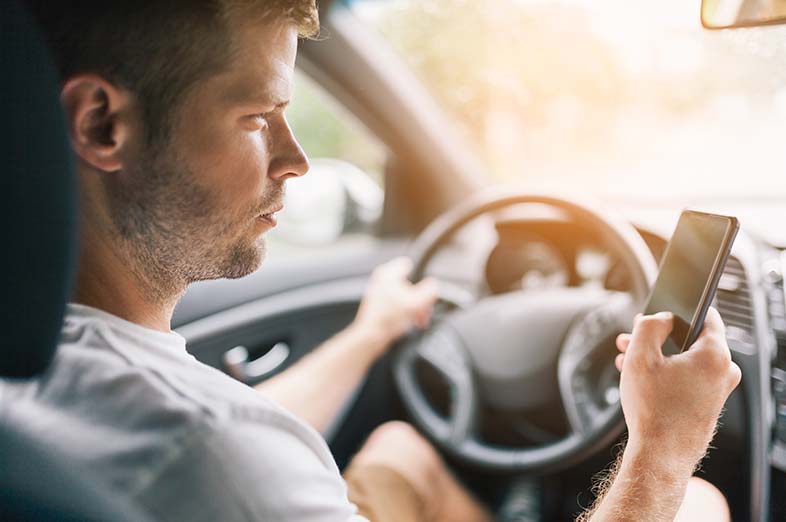Everyone gets distracted, but drivers should never let that happen when they’re behind the wheel. Sometimes, a single inattentive moment causes a distracted driving accident in Minnesota. Drivers must dedicate their hands, minds, and eyes to controlling their vehicles and responding to dangers. Any type of distraction changes this dynamic like picking up a phone to call or text, taking focus away from what they should be doing.
Each day, motorists prioritize their need to communicate over their driving obligations. They cause serious property damage and life-changing injuries while chatting on their phones or checking their text messages. If a distracted driver causes a car accident that injures you or a loved one, contact our Minnesota distracted driving accident attorneys at Nicolet Law Accident & Injury Lawyers about your right to recover compensation.
Why You Need Nicolet Law Accident & Injury Lawyers When a Distracted Driver Injures You?

When a distracted driver crashes into your car, you must still prove that they caused your accident. Law enforcement agencies have difficulty proving that a driver was using a cell phone or other digital device. They often rely on self-reported use, and most drivers won’t confirm that they were talking on the phone before they lost control. Even if an enforcement agency has the authority to subpoena a driver’s phone records, they can’t necessarily prove that the driver was actively texting.
Our distracted driving attorney understands all of the relevant issues. When we investigate our clients’ claims, we concentrate on evidence that proves the driver committed a negligent act. When you establish a working relationship with Nicolet Law Accident & Injury Lawyers, our attorneys will work to resolve the complicated liability issues on your behalf. We handle your case while you focus on healing—and we get results.
Injured in Minnesota? Get Nicolet.
Distracted Driving In Minnesota

Distracted driving has always been a problem, but cell phone ownership and use have elevated the issue to new heights. Not all drivers use their phones while driving, but increased functionality has increased the temptation. A smartphone lets a driver talk, text, check maps, view destination information, and activate audio GPS directions. They let drivers check out their favorite influencer videos, do face-to-face calls, and record their surroundings while driving.
Pew Research has tracked cell phone ownership and determined that 62 percent of Americans owned cell phones in 2002. Their most recent statistics show that 97 percent of Americans own cell phones. Eighty-five percent of these cell phone owners have smartphones.
These figures reflect phone ownership across all demographics. This means that practically every driver you pass on the road has immediate access to a phone. While they might not be using it when you pass them, if someone calls, they might not be able to ignore their favorite ringtone.
Minnesota Distracted Driving Statistics
Despite cell phone laws and trendy safety campaigns, distracted drivers still cause accidents. In Minnesota, the Office of Traffic and Safety (OTS) tracks annual casualty statistics based on police-investigated accident reports. Minnesota law enforcement agencies determined that distracted driving was a factor in over 39,000 vehicle accidents since 2016. Their data also shows that distracted driving is responsible for 11 percent of vehicle-related fatalities in Minnesota.
The OTS’s most recent annual data provides these statistics.
- Total Distracted Driving Accidents: 2,612
- Total Injuries: 160
- Total Fatalities: 29
Distracted Driving Laws

Most states have long-standing laws that prohibit the type of driving that makes cell phone use so dangerous.
Language in Minnesota, §169.13 describes reckless or careless driving, but it could easily define a person who chooses to drive distracted:
- Driving “while aware of and consciously disregarding a substantial and unjustifiable risk.”
- The risk “constitutes a significant deviation from the standard of conduct that a reasonable person would observe in the situation.”
- Operating a vehicle “carelessly or heedlessly in disregard of the rights of others in a manner that endangers or is likely to endanger any property or any person.”
While these statutes target the type of driving in which cell phone users regularly engage, they focus on the driver’s state of mind. With personal technology becoming a critical factor in vehicle accidents, newer laws relate more specifically to actions while using digital devices. These laws vary from state to state and show no consensus as to a solution to the distracted driving problem.
The Governor’s Highway Safety Association’s Distracted Driving Chart shows state law variations in banning cell phone behaviors.
- Handheld bans: Some states completely ban handheld device use while driving. Some ban handheld device use only in school zones, construction zones, on school property, or for certain driver’s license categories.
- Complete ban for specific circumstances: Some states prohibit school bus operators and novice drivers from using any cell phone while driving.
- Text message bans: Most states have comprehensive text message bans.
- No cell phone bans: Montana is the only state without phone restrictions for drivers. Missouri has only a texting ban for drivers under age 21.
Minnesota’s Distracted Driving Law
In 2019, the Minnesota Legislature addressed the state’s distracted driving issue by passing §169.475, Use of Wireless Communications Devices.
The state publicizes its hands-free law using two bold catchphrases, “Put it Away or Pay,” and “Park the Phone.”
- The device ban is in effect when a vehicle is in motion and part of traffic or the driver is operating a vehicle on a street or highway.
- A driver may not hold a wireless communications device while driving or “... initiate, compose, send, retrieve, or read an electronic message...”
- A driver may not engage in a cellular phone call, initiate a call, talk or listen, or participate in video calling.
- A driver may not access video, audio, games, images, software applications, or other content stored on their phone.
- They may use voice commands or single-touch activation if available.
- A driver may use a GPS or navigation system if they don’t touch the device while driving.
Minnesota’s law doesn’t just ban cell phone use while driving. It also prohibits calls on any wireless communications device. This extends the ban to tablets and other digital devices.
Hands-Free Law Penalties
The first time a driver breaks Minnesota’s hands-free law, they must pay a penalty.
- First Violation: a $120 or greater fine (includes court costs)
- Second Violation: $300 or greater fine (includes court costs)
- If you harm or kill someone while violating the law: a felony charge, either criminal vehicular operation or homicide
It's Not Just About Cell Phones

Digital devices have put distracted drivers under the spotlight, but these types of incidents occurred long before the first person texted while driving.
The National Highway Transportation Safety Administration (NHTSA) report, “Investigation and Prosecution of Distracted Driving,” classifies distractions as external and internal.
- External distractions: These include anything outside of a vehicle that draws a driver’s attention away from their primary driving tasks. These distractions sometimes include vehicle crashes, animals, emergency vehicles, children, and distractions considered “attractive nuisances.”
- Internal Distractions: This is anything inside of your car that distracts you from driving the way you should. Internal distractions may include conversations, lunch, applying makeup, and digital devices.
NHTSA further categorizes distractions as visual, manual, cognitive, and combination.
- Visual Distractions: A driver looks at anything other than the road.
- Manual Distractions: A driver takes their hands off the steering wheel to eat, fidget with the radio, smoke, drink, or any other action.
- Cognitive Distractions: A driver becomes distracted by thoughts such as money, children, jobs, etc.
- Combination Distractions: Digital devices often incorporate simultaneous manual, visual, and cognitive distractions.
Driver Reaction Time While Distracted
The NHTSA estimates that sending or reading a text takes a driver’s eyes off the road for five seconds. Those five seconds go by in a flash, but at highway speeds, it’s enough time to delay a reaction to a hazard and cause a crash.
Under typical circumstances, when a driver notices an object in their path, they take an average of three-quarters of a second to decide to stop. They need an additional three-quarters of a second to take action. It takes four and a half more seconds before the vehicle slows down and stops. When a driver applies the brakes while traveling 55 miles per hour, their vehicle continues rolling for 265 to 303 feet before stopping.
A distracted driver doesn’t always notice a hazard, an accident, or an animal in the road ahead, so they don’t react at all. They don’t even apply the brakes. If they do notice in time, they don’t always stop quickly enough, so they can’t avoid an accident.
Motorists Still Drive Distracted
Despite ongoing NHTSA ads and DPS safety campaigns, vehicle operators still drive distracted. They cling to their digital devices, groom on the way to work, and eat lunch in traffic. Whatever their distraction, their actions/inaction often contributes to tragic outcomes.
NHTSA compares distracted driving to driving under the influence of alcohol or drugs. It involves common activities such as speeding, inattentiveness, and an impaired reaction to dangerous circumstances. Drivers don’t notice their surroundings, so they don’t notice when danger is right in front of them.
They Still Cause Accidents and Injuries
While Minnesota’s recent fatality statistics show an improvement over previous years, officers still see accidents with deaths and injuries. When a distracted driver crashes into another vehicle, they cause the same types of casualties as speeding, drowsy, alcohol-influenced, and drugged drivers. As with any of these types of accidents, speed increases the impact and causes a range of injuries.
These are common motor vehicle accident injuries:
- Spinal cord trauma
- Muscle sprains and strains
- Traumatic brain injury
- Disc and spine injuries
- Severe Burns
- Multiple fractures
- Internal organ damage
- Fatal injuries
Hands-Free Doesn't Mean Risk-Free

Nearly every state has a law controlling cell phone use while driving. Many, including Minnesota, prohibit all but hands-free devices. The National Safety Council doesn’t believe that hands-free laws are enough. They question the validity of any type of activity behind the wheel other than driving. The organization supports a complete ban on digital devices in vehicles.
The Distracting Voice
The NSC’s research shows that it’s not usually a digital device that causes distraction. It’s the process of driving while reacting to a disembodied voice demanding attention. It creates a cognitive distraction, whether it’s coming from a handheld or a hands-free device.
The NSC’s white paper “Understanding Distracted Driving” explains that people aren’t actually multi-tasking when they’re driving and talking on a phone.
- People can’t accomplish more than one cognitively demanding task at a time.
- Their attention quickly alternates between tasks.
- One task takes priority, and the other becomes secondary.
- Multi-tasking attempts (talking on the phone and driving) increase the brain’s workload, and processing (scanning, predicting, identifying, decision-making, executing a response) slows down.
Inattention Blindness
Scientists have documented the phenomena where a driver simply doesn’t see an object while driving. This often occurs with vehicle operators and motorcycles. The NSC’s report also associates the look-at-but-don’t-see issue with in-car cell phone conversations. They estimate that even when a driver is talking on a hands-free device, they see only 50 percent of what’s around them. This inattention blindness or tunnel vision prevents safe driving.
The National Transportation Safety Board Agrees
The National Transportation Safety Board’s goal to eliminate distracted driving appears regularly on their Most Wanted list. The list cites transportation improvements they most want to change. While investigating major train, plane, boat, and trucking accidents, they have found that all phone conversations create cognitive distractions that put drivers at risk.
They recommend:
- Banning drivers from using all personal electronic devices
- Enforcing existing laws and strengthening monitoring and enforcement programs.
- Educating the public about distracted driving dangers.
- Encouraging fleet owners to prohibit cell phone use and implement lockout features on company cars.
Contact Our Distracted Driving Accident Lawyers

When a distracted driver injures you or your loved ones, you should never handle your case without legal assistance. When you work with Nicolet Law Accident & Injury Lawyers, our distracted driving attorneys take immediate action on your behalf. We investigate complicated liability and damage issues. When appropriate, we contact responsible parties, their insurers, and their legal representatives.
Reach out to us when you’re ready to discuss your case and learn more about your legal rights. Please click our chat box, call us at (612) 446-3999, or visit our contact page and leave a detailed message.
Minneapolis Office
Address: 43 SE Main Street, Suite #500,Minneapolis, MN 55414
Phone: (612) 888-8258